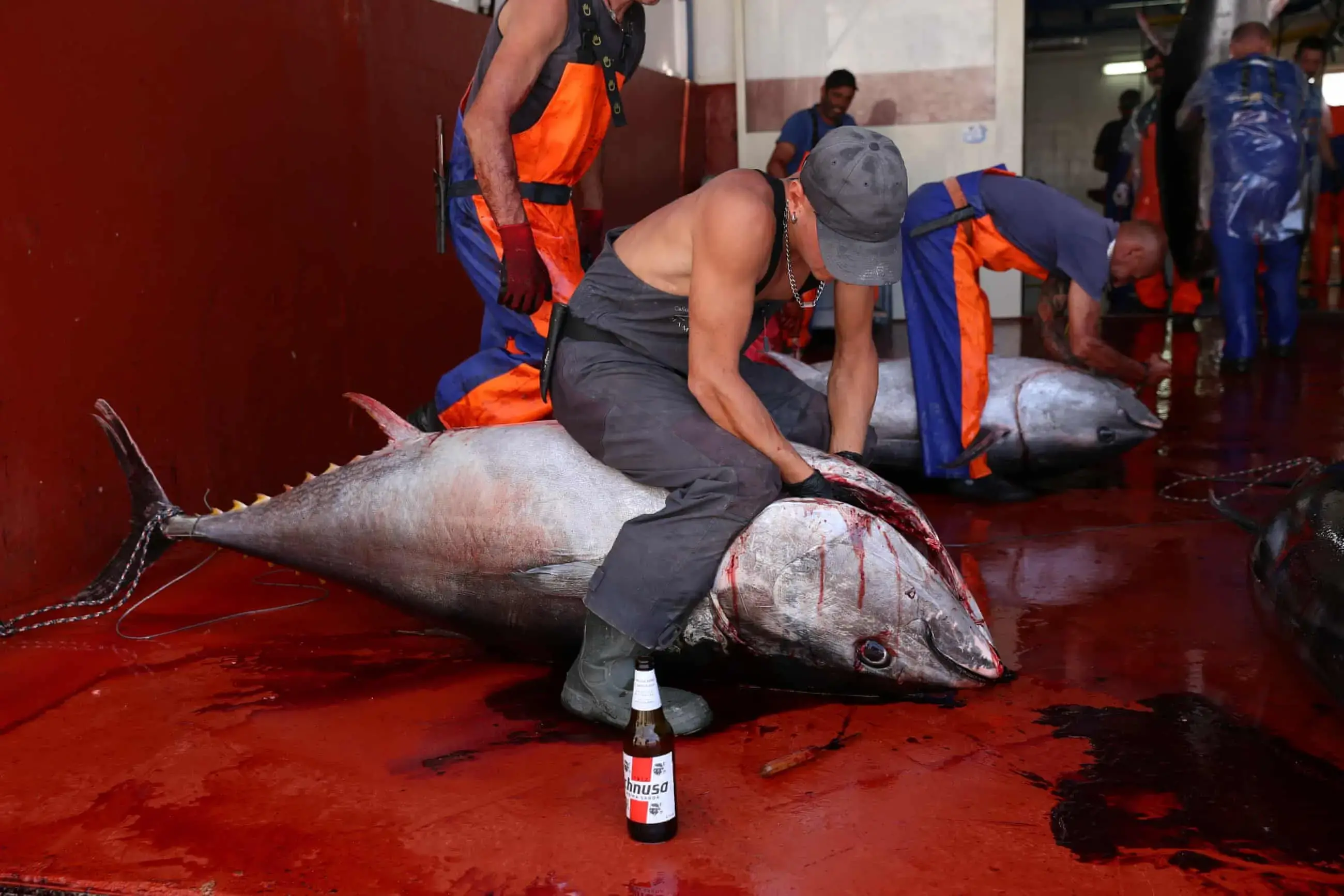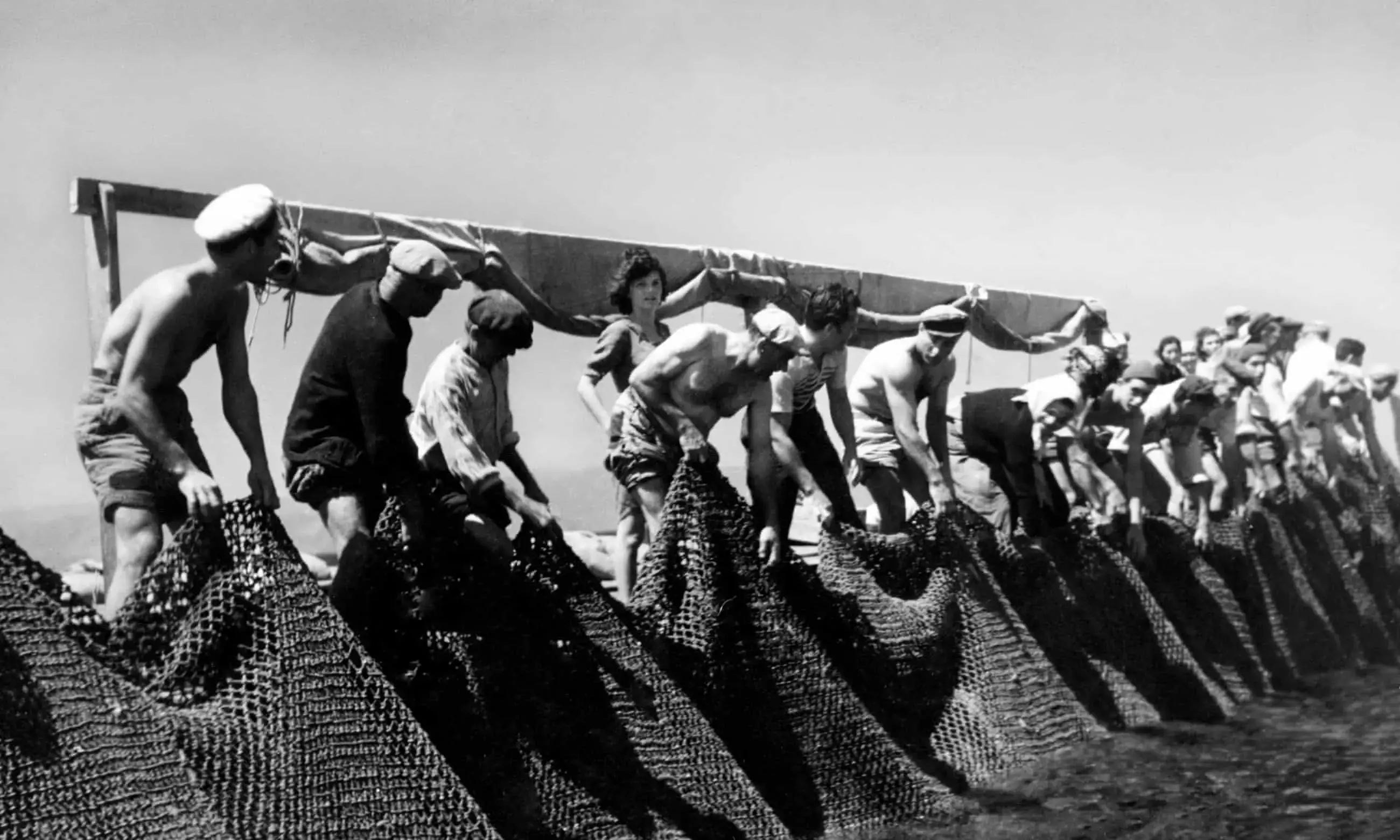
A sustainable technique for catching tuna that goes back thousands of years is on the verge of extinction in Italy – but not for a lack of fish.
On an overcast morning, several miles off Sardinia’s east coast, four men jump into a net where 49 giant Atlantic bluefin tuna are fighting for their lives. For 30 minutes, the men struggle in a frenzy of nets, tails, fins and sleek silvery bodies before finally securing a metal hook through the gills of the nearest fish.
From one of seven wooden boats framing this càmira dâ morti (“chamber of death”), Luigi Biggio yells for his men to pull.
As 28 men look on, a majestic creature about three metres long, weighing 120kg (265lb), is raised from the water with a pulley. On the biggest boat, one man swiftly cuts its jugular and the vessel fills with blood.

As a nonprofit journalism organization, we depend on your support to fund our nationwide Connected Coastlines climate reporting. Donate any amount today to become a Pulitzer Center Champion and receive exclusive benefits!
Biggio, 57, runs a tonnara, Italy’s version of an ancient Mediterrranean fishing custom, which traps and harvests bluefin tuna in the intimate, gruesome struggle known in Italian as the mattanza (“killing”). He comes from a long line of raís (from the Arabic for chief), almost sacred leaders of the hunt – a mantle passed from father to son in designated families.

The harvest is violent and can seem barbaric, as the dying tuna are hooked, stabbed and hoisted on to boats. However, fisheries experts regard it as a rare sustainable method of catching bluefin tuna, one of the world’s most overfished species.
Despite its merits, Italy’s tonnare face extinction. But they are not disappearing due to a lack of fish. While the practice was threatened in the early 2000s by a collapse in tuna populations due to commercial overfishing, EU regulations helped tuna numbers recover over the past decade.
"They fish tuna with Italian quotas and then sell the fish through Malta all over the world – except in Italy."
— Fabio Micalizzi
“We carry on a tradition that’s thousands of years old,” Biggio says. “We continue it with pride.”
But Italy’s small-scale, traditional fishers have largely failed to secure permits under successive governments under the quota system, and are now struggling to compete with big fleets in the region.
While in the 1920s, more than 50 groups fished this way across Italy, Giuliano Greco and his family, who own the tonnara that Biggio runs, also own half of the only other such fishery still active.

“[The tonnara] is the only eco-friendly system for bluefin tuna fishing because it does not touch or disturb the rhythms and biorhythms of tuna stocks,” says Greco, who has been working with Sardinia’s Tonnara di Carloforte since the early 90s, taking over the business from his father.
Unlike modern seine-net and trawler fishing vessels that catch everything in their paths, the tonnara nets are designed to catch only adult tuna, which ensures the fish return the next season. It also employs dozens of people in the community.
With its swift harvest, the fish may suffer less compared with the slow suffocation in trawler nets. However, even the WWF – which considers the tonnara as sustainable – warned against making a spectacle of it.

Italy’s tuna quotas are held by a few boats. “They fish tuna with Italian quotas and then sell the fish through Malta all over the world – except in Italy,” says Fabio Micalizzi, a Sicilian fighting for fairer distribution of quotas.
Atlantic bluefin tuna are among the world’s most expensive and sought-after fish, occasionally selling for millions of dollars in Asia. In the 1960s, as global demand grew, large-scale fishing methods such as purse-seine fishing and longline fishing spread.
Purse-seine fishing, the most common commercial method, involves dropping a cylindrical net around entire schools and closing it up at the bottom. This results in the highest bycatch of unwanted fish and other sealife.

As a result, bluefin tuna populations in the Mediterranean plummeted to critical levels by the early 2000s.
In an effort to stop overfishing, the EU implemented an extensive recovery plan in 2009. It allocated fishing quotas to member states, put limits on the number of boats allowed to fish and mandated a 30kg minimum weight for fished tuna.
The ambitious plan seemingly paid off. Tuna populations rebounded so successfully that, since 2014, large boats “capture their yearly tuna quota in a day”, according to Alessandro Buzzi, of the WWF Mediterranean Marine Initiative.
“Many newspapers still report today that tuna is an endangered species,” he says. “Luckily, the tuna can’t read the stupid things that humans write because otherwise it would get worried.”

But the quotas that have helped fish numbers to recover have been “truly disastrous” for artisanal fishers, says Greco. The EU plan anticipated member states distributing quotas among local communities. But in Italy these became skewed toward larger companies.
“If I could, I would sue the Italian government because of what it has forced us to lose in recent years,” Greco says, pointing out that, in 2023, Spain distributed 24% of its allotted fishing quotas among its tonnara, known there as almadraba, while the Italian government only managed 8%.
As a result of the quota distribution, it is illegal for many small fishers in Italy to catch tuna. Even landing tuna as bycatch while fishing for other species can be penalised. “Whether you want it or not, the tuna jump into your boat,” says Micalizzi in Sicily. “If we professional fishermen catch it, we become killers and thieves.”

In 2023, the Italian government redistributed a quota for 295 tonnes (roughly 1,200 adult tuna) out of 5,282 tonnes in total to small operators. But Micalizzi says that is far too little, especially since most of the Italian quota is allocated to a few seiners and longliners.
Meanwhile, in Sicily, there have been multiple reports of people becoming sick with scombroid poisoning from eating badly conserved tuna, potentially fished without the right permits.
“In these games who is the loser? The smallest,” says Antonio Di Natale, a UN expert on sustainable fisheries and former research director at the International Commission for the Conservation of Atlantic Tunas (ICCAT).
"In these last few years, the tuna have got bigger and bigger. So in that sense, the quota worked."
— Stefano Sanna
As one of the oldest human industrial activities, according to Di Natale, the tonnara should be protected as a Unesco “intangible cultural heritage”. It is also invaluable as a sustainable fishing practice as it so easily controlled and highly selective, he adds.
Today, much of the wild tuna caught in Italy is slowly transported in large floating cages to Malta, Spain and Croatia. There, they are fattened for up to six months to appease lucrative markets such as Japan that prize large and fatty fish.

“There is nothing illegal in this practice,” Buzzi says. “But the impact of farming a tuna in a cage is not even comparable to the environmental impact of catching a wild tuna.”
This year, before the harvest, Greco’s team released a shoal of 1,200 young tuna from their nets because they were too small. “What other fishing system allows for such selection?” he asks. But running a tonnara is neither quick nor cheap.
While a big seine boat can go out with a small crew and catch the entire year’s quota in a week, the preparation of the tonnara takes about six months. The multi-chambered nets spanning 3km (and 40 metres deep) take two months to prepare and two days to mount at sea using 122 anchors.
Greco says he invests €1.5m a year in the tonnara, and employs about 50 people. However, to fund what is one of Italy’s last two tonnara, he reluctantly sells 75% of his trapped fish to large-scale tuna cagers.
“I don’t like fattening them,” says Greco. “It certainly doesn’t create first-rate fish and it pollutes … I would have declared cages illegal.”
But Greco is also hopeful. His tonnara is open to tourists who want to learn about the ancient practice – and it helps that they buy his premium-quality tinned tuna for €25 a pop.


At sea, the harvest is done, and one of the fishers calls for silence. “May the holy sacrament be thanked. In the name of Saint Anthony, let go,” he says. The others respond: “Aoooohh!” Most of Biggio’s team return to shore with their 49 giants, weighing six tonnes in total.
But one boat stays behind. On it, several exhausted fishers sip local Ichnusa beer and bask in the sun.
“In these last few years, the tuna have got bigger and bigger,” muses Stefano Sanna, a tonnara fisher for 25 years. “So in that sense, the quota worked.”













